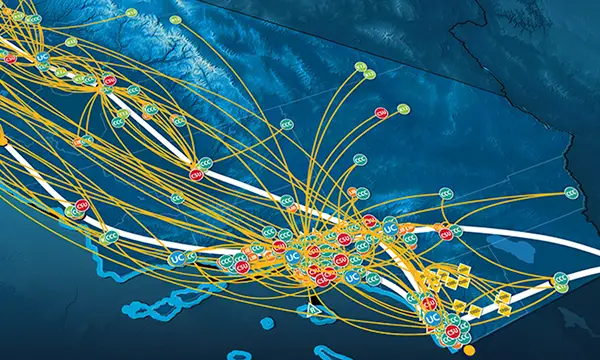- About
- Network
- Community
- Initiatives
- News
- Events
- Blog
- Publications

Internet Exchange Points: An Essential Infrastructure for Rural Broadband Initiatives
Categories RENS & NRENS Equity & Access
Internet Exchange Points (IXPs) are a vital part of the network of networks that is the Internet. Without them, the Internet could not function because the different networks that make up the Internet would not be able to exchange traffic with each other. The simplest form of an exchange point is a direct connection between two Internet Service Providers (ISPs). When more than two providers operate in the same area, an independent switch operates more efficiently as a common interconnection point at which to exchange traffic between the local networks. This is similar to the development of regional airport hubs where many different airlines are served. At these locations, airlines exchange passengers between their flights in much the same way that networks exchange traffic across the IXP.
IXPs are one of the building blocks around which the Internet is built. They are the physical locations where networks come together, and where content providers place content closer to end users to increase the speed and efficiency of networks. Currently, there are dozens of IXPs nationwide but most of them are concentrated in big cities. Increasing the number of IXPs across California will result in a more resilient, competitive, and interconnected Internet (especially for households in more rural areas). IXPs are carrier-neutral: that is, they are not limited to one service provider. They encourage all providers to serve an area by making service more cost-effective, both for the providers and for customers, by creating a competitive environment for services through colocation and interconnection.

Creating and operating IXPs in appropriate rural locations, and locating them near the rural “last mile,” will significantly enhance broadband services in locales underserved with broadband today, as well as areas that are currently unserved. These IXPs can support the goals of California Advanced Services Fund (CASF) middle- and last-mile efforts, the federal Rural Digital Opportunity Fund (RDOF), and other prospective state and federal broadband programs under discussion.
Regardless of rural last-mile broadband speeds, rural IXP facilities would produce better broadband performance for rural users by keeping local traffic local. Rural IXPs would allow rural broadband users to experience significantly lower latency to/from local resources, such as K-12 school district resources, especially for latency-sensitive applications like video-based, remote tele-learning; similarly, interactive telehealth video-sessions would be appreciably enhanced, as would access to all local content – government, commerce, news, and public safety.
These rural IXPs could also provide appropriately scaled, dynamic, content caching services that would greatly enhance the content delivery performance of rural broadband, whether the content is local or global, academic or otherwise, by bringing the content closer to customers, and by providing local access to a range of cloud services. We also imagine that such facilities will be central to the Internet of Things (IoT) and, in particular, to the increasing use of sensor networks and other precision agriculture applications.
For Internet providers, there are many advantages to local routing of Internet traffic via an IXP:
- Substantial cost-savings are made by eliminating the need to put all traffic through the more expensive long-distance links to the rest of the world.
- For traffic not exchanged locally, a rural IXP would be an aggregation point for local ISPs and WISPs, and could provide affordable backhaul to major urban IXPs, where Tier 1 ISPs could be accessed.
- More bandwidth becomes available for local users because of the lower costs of local capacity.
- Local links are often up to 10 times faster because of the reduced latency in traffic, which makes fewer hops to get to its destination.
- New local content providers and services, which rely on high-speed low-cost connections, become available, further benefiting from the broader user-base available via the IXP.
- More choices for Internet providers become available about how to send upstream traffic to the rest of the Internet—contributing to a smoother and more competitive wholesale transit market.
There are many operational models for IXPs, among them: (1) a non-profit industry association of ISPs; (2) a carrier-neutral for-profit company; (3) a carrier-neutral non-profit organization; or, (4) a university or government agency.
These rural IXP measures alone will obviously not get gigabit-level services to rural users any sooner. However, they will ensure that rural last-mile broadband, especially if below gigabit speeds, is more efficiently and effectively used by attracting multiple carriers and services, and they will lengthen the amount of time before a rural last-mile user’s bandwidth needs to be increased.

The last question about IXPs is where they should be sited and how many might be needed. Presumably, IXP operators would have some metrics: latency, distance, radius, along with the number of prospective ISPs and WISPs, content companies, and cloud providers who might attach. Operationally, too, there is a cross-over point when too many IXPs becomes too expensive to attach to for providers, where port fees are too high for the amount of traffic that is exchanged, and where operational costs are too high for an IXP operator or operators. For now, we are recommending looking at the number of IXPs from a county perspective, rather than “one per mayor.”
Despite some complexities, we believe that rural IXPs could leverage federal, state, and local investments and their impacts, immediately and over time. Terminating a middle-mile infrastructure at an IXP increases the value of the middle-mile infrastructure at both ends: at the interconnection with long haul networks, where there is greater potential to attract cloud, content, and applications providers; at the other end, the rural community, creating a richer, diverse and more competitive environment for consumers, and substantial cost-savings for ISPs and WISPs to provide last-mile services.
Related blog posts
The Big Game Is Big Data: How CENIC and the California Research and Education Network Support Member Athletics
When Fresno State needed to connect to Pac-12 Enterprises to broadcast a live football game over CBS, the Chancellor's Office reached out to CENIC for what Pac-12 later called the smoothest turn-up they've ever experienced.
Enabling Network-Based Collaboration Around the World: A Tour of CENIC and Partner Network Maps
On the Network Maps page at the CENIC website, you’ll find maps of all the networks, peering facilities, and exchanges to which CalREN connects, showing how thousands of CENIC member institutions connect to CalREN and to colleagues all over the globe.


